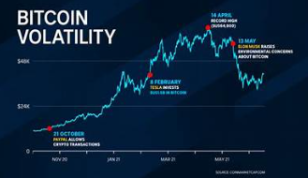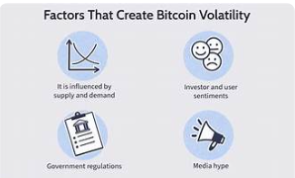Knowledge is power
Crypto Volatility: Causes and Consequences
What is crypto volatility?
In short: crypto volatility is like a roller coaster—without seatbelts. It measures how wildly a coin’s price can swing over a given time period. Bitcoin, Ethereum, and the rest love to pull sudden “pump & dump” moves, making the market super exciting… and nerve-wracking. Traders live for the adrenaline rush; investors? Not so much.

Why are cryptos so wild?
Crypto volatility isn’t random—it’s baked into the system:
- No central regulation: No Fed, no central bank. If chaos hits, the market decides. Sometimes it’s a boom; sometimes you get totally rekt.
- Low liquidity: Small-cap coins can jump 20–30% in a day if a whale pumps or dumps.
- New, unpredictable market: Crypto is the toddler of financial markets. Gen Z investors + hype = extreme swings.
- News and FOMO: Hack attacks, Elon tweets, regulatory crackdowns—even a meme can move prices by double digits. or
Volatility example: Bitcoin

Bitcoin is the king of chaos. In 2017 it skyrocketed past $20,000, then plunged to $3,000 in 2018. Holders cried; traders celebrating the “bull ride” popped champagne.
Even during the 2020 COVID-19 crash, crypto showed its classic waves—if you knew how to surf them, you could scalp some serious gains.
How to profit from volatility
Volatility is a trader’s playground:
- Day trading: Buy low, sell high—every single day. Like catching falling knives, but with adrenaline.
- Swing trading: Hold coins for days or weeks, riding medium-term price swings. Less stress, still profitable.
- Hedging: Options and futures for pros who want to shield themselves from sudden price attacks.
How to lose money on volatility

Volatility cuts both ways:
- Unpredictable moves: Even seasoned crypto gurus get it wrong—sometimes badly.
- Emotions run wild: Panic selling? FOMO buying? Classic mistakes—sell the dip, buy the top.
- Margin trading: Borrowed funds can blow up your position if the market moves against you.
- Liquidations: On some platforms, a sudden drop triggers automatic stop-outs, sometimes wiping your position completely.
How to manage risk

Some pro tips to survive the crypto jungle:
- Diversification: Spread your capital across multiple coins to reduce risk if one crashes.
- Stop-loss orders: Automatically sell at a set price to limit losses.
- Education & analysis: Knowledge is power—study the charts, understand the market, avoid rookie mistakes.
Conclusion
Crypto volatility is both a golden ticket and a trap. Massive price swings can lead to quick gains—or total wipeouts. Approach the market with caution, have a plan, and remember: in crypto, fortune favors the prepared.
Fun fact: The Bitcoin network processes around 300,000 transactions per day—enough chaos to keep even the most seasoned traders on their toes. ⚡